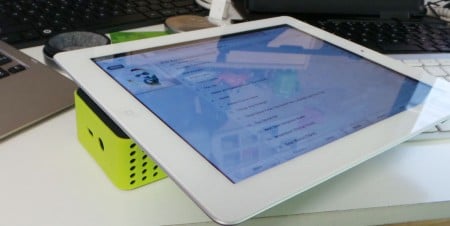There’s a new wireless speaker technology coming to town, and rather than require Bluetooth or WiFi, it works by just resting your phone on top and letting the music come out. And it’s so easy, anyone can use it.
One of the surprising stands from our trip to the Consumer Electronics Show in Las Vegas this year was that of RCA, a company that doesn’t exactly have a presence in Australia (not anymore, anyway).
There, it was presenting devices with “SoundFlow,” a technology that an RCA representative told us ran off of Near-Field Audio, a new wireless audio concept that “just worked”.
What do they mean by that?
Well, you take your phone, play some music using the speaker, sit the phone on top of the speaker, and the sound is amplified. There are no drivers to install and nothing special to synchronise, nor does it rely on Near-Field Communication technology, despite the obviously similar name.
It just works.

In Australia, Kaiser Baas has grabbed the first products with this tech for release on what appears to be a rebadging of the first one released in America – the iFrogz Boost – and calling it the “Contact.”
This is a speaker about the size of a small brick, powered by three AA batteries, and featuring a microUSB charge port (if you don’t want to use batteries) and a 3.5mm line-in port (though no 3.5mm stereo cable is included). Two rubbery bumpers are included in the box, allowing you to colour your device in either red or green, and there’s a little pouch included too, which should protect it when in transit.
Like any speaker, you can plug in a device with the audio in port (the 3.5mm jack), but there’s also another way to get the speaker to amplify your music.

With Near-Field Audio technology on board, the Kaiser Baas Contact can amplify the sound already coming out of your speaker when it comes in contact with the surface of the speaker.
One of the chief questions concerning Near Field Audio is, curiously, how it works, and no one seems to have any definitive answers.
At CES, one representative for RCA told us it had to do with magnets and capturing the audio being emitted from the speakers, with the speaker basically acting as an amplifier for the audio coming from the magnet in the speaker itself, which corroborates with a review of the iFrogz product at Sound & Vision magazine.
Other ideas suggest that the technology works from a hidden microphone in the lid or something that amplifies the vibrations, but while we have yet to have an official explanation shown to us, the magnetic amplification seems to make the most sense.
Regardless of how it’s working – like “magic” they say – using it is quite simple.

Just make sure your phone or media player is playing music out loud through its speakers, turn the Contact speaker on, and lay your device on top, with the back facing down. From there, the Contact takes over, amplifying the sound.
You can increase the volume considerably, though we wouldn’t say it’s a very high quality of sound. Volume is controlled from the device itself – your phone, for instance – so if your music is a little low, it might be because the volume on your operating device is low, too.
There are some catches to how the Contact works, however.
Devices larger than the overall footprint of the speaker’s surface may not work. For example, the iPad wouldn’t work and only made the Contact produce static for us. Gadgets without a speaker – say an iPod Nano or Shuffle – may have a different problem, since there are no speakers on those units.
Meanwhile, we had no problems getting sound out of mobile phones and cameras, with the speaker amplifying audio out of them. It even worked with a Livescribe pen, making the audio louder.
For anything that doesn’t work with the contact-based method on top, just use the 3.5mm jack on the side.

The included rubber cases block the light on the side telling you when the device is switched on, which is a little annoying. You can move it out of the way quickly, but about the only thing these do is offer light protection for the speakers on the side, since they merely wrap the edges of the speaker, not the top or bottom.
You also can’t move your device, either, nor is there any charging provided, so if you need to watch the screen or are in desperate need of some power, the Contact won’t really accomodate you.
Ultimately, if you don’t need quality, but desire a speaker that just works with your smartphone and provides some loud sound, you’ll be satisfied here, especially with the $60 price tag.









